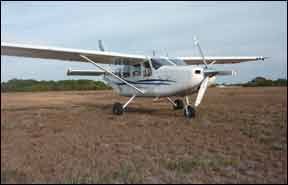The heavy-hauler aircraft niche is such a sub-specialty that not many dedicated models exist, with Cessna’s Caravan being the most obvious success story. Piper’s Saratoga and the 200 series from Cessna qualify, but none are devoted purely to the lots-of-people or the lots-of-boxes role. That certainly can’t be said of the Gippsland Aeronautics GA-8 Airvan, an aircraft that’s unabashedly devoted to hauling stuff. A lot of stuff.
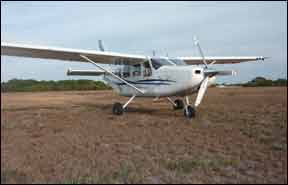
We were first introduced to the Airvan 10 years ago, just after it appeared as what we might now call the leading edge of the world or international airplane. Built in Australia, the model hasn’t been a huge seller, but with about 170-plus flying, it’s gained a foothold.
Two years ago, Gippsland (pronounced with a hard G) got a huge cash infusion from the Indian industrial conglomerate Mahindra and it has put the capital to work developing two new models, the GA8TC we flew for this report and a soon-to-fly turbine version called the GA10, which will use the Allison/Rolls turboshaft found in the conversions we reported on in the February 2012 issue of Aviation Consumer.
This airplane is best thought of as resting between compromised haulers like the Cessna 206 and perhaps the Cherokee 6/Saratoga and the muscular Cessna 208 Caravan. It’s got a larger cabin than the former, but it’s cheaper to buy new and operate than the Caravan is.
But that’s not to say cheap, exactly. The normally aspirated GA8 sells for about $699,000, while the GA8TC we flew would sell for about $800,000, equipped with the optional cargo pod.
Model History
George Morgan, a Gippsland co-founder, and U.S. rep Randy Juen dropped by our home airport with the new GA8TC. Gippsland is relatively new to the North American market, but it’s by no means a new company. It was formed in the 1970s as a maintenance and mod house.
Because Australia—and Australasia, for that matter—has more outback than urban area and more unimproved airstrips than runways, Gippsland saw space for piston-powered hauler with good STOL capability.
Using the GA200C as the certification starting point, Gippsland began work on the GA8 in 1993, obtaining Australian approval in 2000, followed by U.S. and Canadian approvals. Morgan and his partner Peter Furlong had in mind an airplane that would haul more and be more durable than the Cessna 206, without resorting to a turboprop engine which introduced size complications, not to mention a price they thought few could afford.

The result is a boxy airframe that looks a little like a Sanforized Caravan. In fact, at a distance, the airplane could be mistaken for a Caravan, even though the viewer will sense that the size isn’t quite right. The box, it turns out, is the ideal shape for, well, more boxes inside, six passenger seats or combinations of freight and passengers through a highly flexible loading strategy.
While the airplane is hardly as large as a Caravan, it’s not exactly small, either. The constant-chord, strutted wing spans 40 feet, 8 inches and the tail span is 13 feet, 7 inches, with an enormous stab and elevator. (More on that later.)
Construction is conventional riveted aluminum throughout, with judicious use of carbon, Kevlar and glass in the cowling sections. The cowl itself is a four-piece affair, with two removable side panels, a center top panel and a lower, single-piece cowling. The carbon fiber is expensive, but has better fatigue life than aluminum and proved more heat resistant in burn tests. We also noted use of carbon fiber in the engine baffles, which ought to reduce cracking.
Speaking of the engine, the GA8TC uses the Lycoming TIO-540-AH1A, a 320-HP variant that’s essentially the same engine found in the Turbo Saratoga. It swings a three-blade Hartzell prop specifically developed to work with the GA8TC’s lower-drag cowl.
Gippsland spec’d dual oil coolers for its engine installation because the airplane is intended to operate in hot desert climates where overheating would be a problem. For maintenance ease, it’s also got an Airwolf remote filter mount, with the can positioned vertically to reduce the mess.

Nice Touches
Although by no means a luxurious airplane, the GA8 is loaded with basic structural features and pilot-friendly perks that impressed us. It’s built to FAR 23 Amendment 53, so it has all the latest crashworthiness additions, including a beefed-up firewall structure to protect the cabin and energy-absorbing seats for the crew and passengers. To protect cabin integrity, a pair of beefy vertical box structures form the front portion of the cabin and tie into the spar structure for the wing.
The cabin itself is large enough for six seats with an aisle. We would call it comfortable if not commodious when all the seats are installed. The main door sill is 33 inches above the ground, so a small removable step is a nice a touch. So is a large, openable-in-flight sliding door that provides a 42-inch opening—plenty of room for cargo of all sizes, including 55-gallon drums and motorcycles.
Gippsland has obviously paid attention to customer demands for commercial common sense since this is, after all, a working airplane. Thanks to quick-connect sockets on the floor, it can be converted from passenger to freight operation in about 10 minutes, according to George Morgan. There are also load sockets on the ceiling to accommodate cargo netting rated for 18G. Morgan told us a pilot in Australia crashed an Airvan on a foggy GPS approach and lived to tell about. “It pitched him straight into the ground with a full load of freight. The airplane stopped in about six feet. He survived and the cargo net held,” Morgan said.
The fuel is relatively we’ll protected in two wet-wing cells for a total capacity of 87 gallons. The fuel is routed into a header tank under the co-pilot’s seat. While we don’t like the idea of fuel in the cabin, the tank is also a wet cell and double-skinned to protect it against crash damage. Valving, well, there is none—the fuel is on or off via a firewall shutoff. Two slope valves keep the fuel from running downhill if the airplane is parked on a sloped ramp.
Loading, Cabin
When it first appeared, the GA8 had a gross weight of 4000 pounds, but that’s just been increased to 4200 for both the normally aspirated and turbocharged models. The airplane we flew had three empty weight figures, depending on configuration. With an empty cabin—not seats or freight hardware—its useful load is 1879 pounds. With the freight setup, it’s a bit lighter and can carry 1840 pounds, including fuel. With all the seats installed, useful drops to 1730 pounds. That means it can carry eight people, if they’re not much over the standard FAA-issue 170 pounds and you don’t have far to fly. More practically, this is a six- or seven-person airplane for short legs or five or six for longer trips. With four people, you can fill the tanks and bring steamer trunks for everyone.
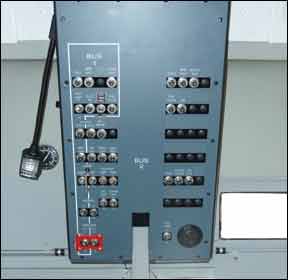
CG is exceptionally forgiving because it’s designed to be. “By configuring the wing relative to the balance point of the airplane, we organized it so when the airplane is empty, it’s very nose heavy,” Morgan told us. “We did that on purpose. Because bush operators aren’t going to be doing weight and balance.”
As a result, says Morgan, if a pilot loads the airplane and does a chin up on the horizontal stab without the tail coming down, the airplane is within the aft CG. However, CG is biased forward, so with two people aboard, the airplane is out of the forward limit. But with its huge elevator and aggressive trim, Morgan says it’s easily flyable. (We agree—we tried it, although with some stuff in the tail baggage area.)
The CG range is so generous, in fact, that the baggage space extends all the way into the tailcone, with an aft capacity of 300 pounds. It can be loaded that way with passengers in the cabin seats. (When Morgan and Juen arrived at Venice, the cabin was packed full of gear, including two bicycles, extra seats and a passenger.)
The rear baggage area is contained by a fabric cover and a net, although getting at it may require navigating or removing the rearmost seats. At 12 pounds, they’re easy to handle.
With its high stance, egressing the airplane looks awkward, but isn’t. Passengers enter the main sliding door, using the removable step. Crew members have their own doors—seaplane operators will love that—with a grab handle and a small step. We didn’t have to be instructed on how to get into the airplane, which isn’t true of all the models we encounter.
The control column has a giant retro yoke on a column that extends all the way to the floor, but it’s no more difficult to scoot by than the typical center stick. Another nice touch we noted was that the pilot doors open a full 180 degrees and are held in the open position by a lock activated by the door latch, thus you don’t have to worry about wind damage if the aircraft is unattended.
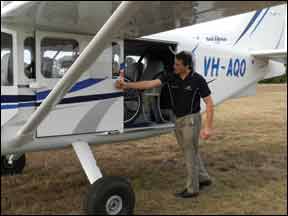
The pilot seats are adjustable fore and aft and with large bubble windows in the doors so visibility out and down is excellent. Although the GA8 isn’t a huge airplane, its cockpit has a big airplane feel. The engine, trim and cowl flap controls are mounted on a large center pedestal and the manual, Johnson-bar flaps are on the floor on the pilot side.
We do have one complaint about the cockpit layout: Master, avionics and lighting switches are on the overhead, along with some circuit breakers. In a small cockpit, overhead panels are a terrible idea, in our view. They’re too close to read the switch labels and you have to manipulate the toggles more or less by memory. Morgan concedes the point and says as avionics become more compact, the switches might migrate to the main panel. We would much prefer this.
The aircraft we flew was semi-glass, with a combination of an Aspen Evolution and steam gauges. It also had a Garmin GTN650/750 combination, but Morgan told us Gippsland can install virtually any avionics that a customer might want, with the exception of large-panel glass like the G1000, which probably won’t fit and which bush operators need like a second head.
Flying It
There’s nothing difficult about operating the GA8. It’s one of the few airplanes we’ve flown that we would feel perfectly comfortable jumping into without even a checkout. Engine start is just like a Cherokee Six or Saratoga, and the cockpit layout has few surprises.
Taxiing is a bit of a trick, however. On the ground, with the aircraft stationary, the rudder pedals don’t budge. It’s like they’re set in concrete. Once rolling, you can turn with the pedals—stiffly—but applying brake only serves to sideload the nosegear. Taxiing is precise enough, but remembering to use no brakes takes some accommodation. The nosegear strut itself, by the way, has an oil-damped steel spring, not an oleo strut, so it should be less maintenance hungry.
We flew the airplane with five people aboard and some baggage in the rear, then once again with only two people on a short grass strip. Frankly, other than some float on landing, we didn’t feel a lot of performance difference. With 320 sea-level horsepower, the airplane doesn’t quite bolt off the runway, but it gathers itself up and accelerates smartly to rotation.

We would describe the control forces as, well, close to perfect. Given the size and weight of the airplane, we would expect a little heaviness but not so. Pitch is pleasantly light—fingertip, really—and roll is just heavy enough to keep the airplane planted when rolling into and out of headings. The rudder remains somewhat heavy in the air, but it’s effective. It’s also somewhat unusual, being what Morgan called a deep-chord, low-set design; it’s broad but doesn’t extend to the top of the vertical fin. Like the elevator, it’s mass balanced for added flutter protection and because of the hard linkage to the pedals, the rudder mass balance obviates the need for a shimmy damper on the nosewheel, saving a little weight. Even at a weight about 300 pounds below gross, the airplane rotates and lifts off easily at about 60 knots indicated and into a climb rate of about 1200 feet a minute which, according to the POH, it should maintain into the low teens. The engine is rated to its full 320 HP to 5000 feet, then 300 HP to its critical altitude of 14,000 feet. The GA8 is, however, not a fast airplane, despite the turbocharger. Dragging it into the stratosphere won’t help. We noted about 125 knots on 14.5 GPH at 4000 feet. Morgan said with careful trimming and patience, 130 knots is doable. So clearly, this airplane is for hauling people and stuff, neither of which will get there fast.
Slow-speed handling is simply superb, the result of a Part 23 airplane taken to its highest and latest level. Trim stability is exceptional, thanks to the forward-mounted wing, large stabilizer and huge elevator. Gippsland worked extensively with the National Test Pilot School in Mojave and it shows. The airplane vsimply settles down to the commanded airspeed and stays here. A dinner-plate size trim wheel on the center console makes minute—and major—trim changes a fingertip thing. What a refreshing change from the chintzy electric trim we’ve become accustomed to in LSAs as a weight-saving measure.
So confidence-inspiring is the GA8 handling that we did something we normally wouldn’t: aggressive slow flight and aggravated stalls with passengers in the back. (They were agreeable.) This the Airvan handled without complaint, especially the aggravated stalls, which it seemed to shrug off, bobbing the nose a couple of times before resuming the GA8 version of parachute mode. Altitude loss was minimal. There’s no pitch change with the application of the first notch of flaps and only slight pitch up with full flaps, requiring very little trimming.
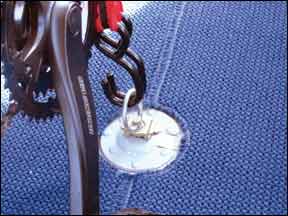
With stalls behind us, we did another thing we wouldn’t normally do: Take a heavy airplane with five people aboard into a 2000-foot grass strip with obstructions. Yet we did exactly that, with performance to spare. Morgan recommended a 70-knot approach speed with full flaps and the GA8 had no trouble stopping in less than half the length of the runway, even without braking.
Unloading three passengers, we tried a couple of more, for which Morgan suggested a 60-knot approach speed. Trimmed to this speed, the Airvan simply nails it, leaving the pilot to make glidepath adjustments with minor power changes. These affect neither pitch nor airspeed. With hard braking, the airplane stopped in under 400 feet.
Conclusion
We’re not often impressed by airplanes merely for their handling traits and even at that, we wouldn’t expect a boxy cargo hauler to be the airplane doing the impressing. But that’s definitely the case with the GA8 Airvan. At every turn, the airplane seems we’ll built and we’ll engineered, with the only clunker we could find being the aforementioned overhead panel.
In our view, the Airvan is we’ll designed for its intended market and the company seems to have responded to the things that cargo and back-country operators say they really want.
Although at $800,000, it might not find much market among private owners, for an operator who needs a revenue-generating working airplane, the Airvan looks good to us. It bests Cessna’s 206 in both payload and pilot friendliness and is a far better handling airplane, in our estimation.
Unfortunately, its high price may limit its appeal to a market like Alaska, where Beavers, 206s and Cessna 185s still carry the day (and the load). But eventually, some of those airplanes will have to be replaced and the GA8 will be the right choice for operators who can make the numbers work.

